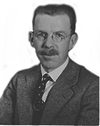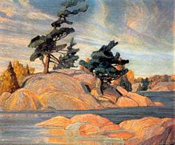FRANKLIN CARMICHAEL
1890 - 1945
 The
youngest original member of The group of Seven, Frank Carmichael was
born in Orillia, Ontario, where he first worked in his father's carriage
shop. His interest in art took him to Toronto in 1911, where he studied
at Central Technical School and at the Ontario College of Art. He
was employed by the commercial art firms of Grip Ltd. and Rous and
Mann, where his colleagues included MacDonald, Tom Thomson, Frank
Johnston, Arthur Lismer and F.H. Varley. The war cut short his studies
at the Academie des Beaux Arts in Antwerp, Belgium, after only one
year. Returning to Toronto, he found space in the new Studio Building
on Severn Street, sharing work room with Tom Thomson and mingling
with the other artists there.
The
youngest original member of The group of Seven, Frank Carmichael was
born in Orillia, Ontario, where he first worked in his father's carriage
shop. His interest in art took him to Toronto in 1911, where he studied
at Central Technical School and at the Ontario College of Art. He
was employed by the commercial art firms of Grip Ltd. and Rous and
Mann, where his colleagues included MacDonald, Tom Thomson, Frank
Johnston, Arthur Lismer and F.H. Varley. The war cut short his studies
at the Academie des Beaux Arts in Antwerp, Belgium, after only one
year. Returning to Toronto, he found space in the new Studio Building
on Severn Street, sharing work room with Tom Thomson and mingling
with the other artists there.
While working with the men who were to form The Group of Seven, Carmichael was included on weekend sketch trips and showed great progress. However, with his marriage in 1915, responsibilities to family and work prevented Carmichael from joining in the sketching trips to Algonquin Park and Algoma undertaken by the others in the later years of the decade. It was not until the major excursions of 1923-24 that Carmichael once again travelled north.
Between times his paintings were drawn from weekend sketching trips to areas not far from Toronto or from his family home in Orillia. October Gold of 1922 was based on a sketch done at Lansing in North York near Toronto, yet it reveals the interests and interpretation typical of The Group of Seven: it could represent a scene of northern wilderness, for there is no hint of nearby urbanization and autumn colours are played against the hills. For Franklin Carmichael, the La Cloche region north of Georgian Bay proved a continuing source of inspiration. The artist first visited the area in 1926 and built a summer cottage there in 1936. La Cloche is the area depicted in the artist's mature work, such as Light and Shadow - strongly designed and delineated vistas of rolling hills, lakes and expansive skies.
 Carmichael
left his job as a commercial artist in 1932 to teach at the Ontario
College of Art and eventually became head of the Commercial and Graphics
Art Department. His reputation as a teacher was enhanced by his work
as a highly acclaimed designer and illustrator. He was also a founding
member of the Canadian Society of Painters in Watercolours, of which
he was president from 1932 to 1934.
Carmichael
left his job as a commercial artist in 1932 to teach at the Ontario
College of Art and eventually became head of the Commercial and Graphics
Art Department. His reputation as a teacher was enhanced by his work
as a highly acclaimed designer and illustrator. He was also a founding
member of the Canadian Society of Painters in Watercolours, of which
he was president from 1932 to 1934.
Carmichael was always on the fringe of The Group, probably due to the difference in age and possibly because he worked fulltime as a commercial artist. Most members of The Group seemed to have the attitude that teaching art was an honourable vocation, but they attached a stigma to working in the commercial field. This seems rather ironic considering almost all members started out in this area.
He was a brilliant craftsman who prided himself on technique, but he was also a rhythmic, musical painter. His earlier works almost resemble tapestries with their flat juxtapositions of colour. As he developed as an artist, he began to emphasize deep, three dimensional space. Although Carmichael's contributions as a commercial artist, graphic designer and illustrator are considerable, perhaps Carmichael's greatest contribution to The Group was in reviving the neglected art of watercolour painting.
Sources: The National Gallery and 'The McMichael Collection'